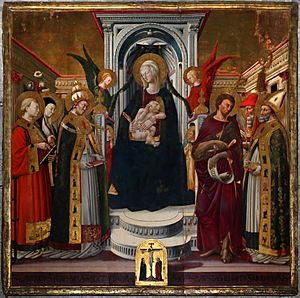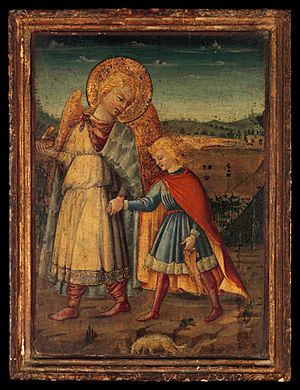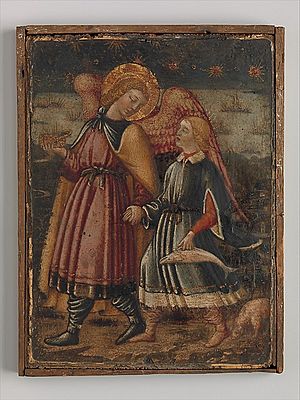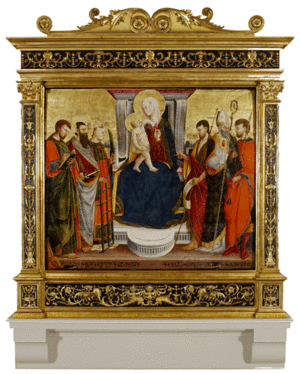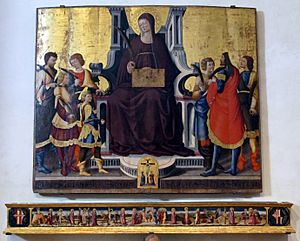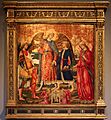Neri di Bicci facts for kids
Neri di Bicci (born 1419, died 1491) was an Italian painter from Florence. He painted many religious artworks. Neri learned painting from his father, Bicci di Lorenzo. His father had also learned from his own father, Lorenzo di Bicci. So, Neri came from a family of talented painters!
Neri di Bicci created many important artworks. These include a fresco (wall painting) called Saint John Gualbert Enthroned with Ten Saints (1455). He also painted an Annunciation (1464) and a Coronation of the Virgin (1472). One of his famous works is Madonna with Child with Four Female Saints (1474).
Neri is best known for his Ricordanze. These were journals he kept from 1453 to 1475. In these journals, he wrote down all the different types of art he was asked to create. He also recorded how much he was paid and who his students and helpers were. These journals are the most detailed records from the 1400s about an artist's workshop. Today, you can find them in the library of the Uffizi Gallery in Florence.
Contents
Early Life as an Artist
When Neri was born in 1419, he was the third artist in the Bicci family. His grandfather, Lorenzo di Bicci, was a well-known painter. He created many altarpieces, frescoes, and small paintings for homes. Neri's father, Bicci, was also a very busy artist.
Neri spent most of his younger years working in his father's art studio. He painted in a style very similar to his father's. In 1434, when Neri was fifteen, he joined a group for Florentine painters called the Compagnia di San Luca.
Neri's Adult Career
Neri created art for all kinds of people. He painted for rich families, government offices, big churches, and small local churches. His first known work was in 1439. He helped his father paint a special monument in Florence Cathedral. In 1440, Neri worked with his father again on an Annunciation painting.
By 1444, Neri started working more on his own. One early painting from this time is a triptych (a three-part painting) called Virgin and Child Enthroned with Ten Saints. This painting shows that Neri's style was changing. It was becoming different from his father's. His work started to show influences from other famous artists like Fra Filippo Lippi.
Neri's father passed away in 1452. After this, Neri took over the family art studio. In the same year, Neri was asked to paint a series of frescoes. These showed Scenes from the Life of Saint Giovanni Gualberto. Only one part of this work, an Annunciation, still exists today.
Famous Artworks
Neri di Bicci painted many important pieces. Two paintings of the Archangel Raphael and Tobias were likely made one after the other. The story of the Archangel Raphael helping Tobias was very popular in Florence in the 1460s. Many artists painted this Bible story.
These two paintings are very similar in style. They were both made in Neri's workshop, possibly with help from his assistants. In both, the Archangel Raphael is on the left, looking back at Tobias and holding his hand. There is also a small white dog and the Archangel holds a box.
One of Neri's most important projects in the 1450s was a special container called a tabernacle. It held an important book in the Palazzo della Signoria. This tabernacle showed Moses and the Four Evangelists, but it was later destroyed.
In 1459, Neri was asked to paint a large altarpiece. This painting, called Coronation of the Virgin with Eleven Saints, is now in the Accademia in Florence. It is special because of its large size and the many people shown in it. Neri mixed older medieval styles with newer ideas in this work.
In 1933, two more paintings were identified as Neri di Bicci's work. One is "Madonna della Cintola". This painting shows the Madonna in the middle with Saint Julian and Saint Thomas. Neri used clear, separate colors in this painting. The faces of the Madonna and angels are flat, while others have more detailed wrinkles. This painting is similar to Neri's "Santa Felicita with Her Seven Sons" (1464). Both show characters with big, curly hair.
The second painting identified was "The Madonna with a Child holding a Pomegranate". This one has richer colors, especially in the faces. The Madonna's face looks more realistic with better shading. Neri's unique style helped identify these works. He often painted long, narrow eyes, arched eyebrows, and long, thin fingers. His Madonnas always have an oval-shaped face. He also painted robes in a thick way, making them look stiff, almost like metal.
In 1456, Neri received a request for an altarpiece of the Virgin and Child with six saints. This painting is now in St. James Cathedral in Seattle, USA. It is one of the few works by Neri di Bicci in the United States. The painting shows the Virgin and Child in the center, surrounded by saints. The way the baby Christ reaches for his mother's blouse suggests the Virgin lactans, or nursing Virgin.
In 1460, Neri was asked to create another altarpiece. He chose to paint a Coronation of the Virgin with Saints. This painting was inspired by the works of Andrea del Castagno.
In 1471, Neri painted an altarpiece for the Palla family chapel in Florence. Wealthy families often had their own chapels inside larger churches. This showed their wealth and generosity. We know Neri painted this artwork because of a record in his workshop book from May 7, 1471. It says he began painting for Mariotto di Marco della Palla. The painting would show the Angel Raphael and Tobias, with Angel Michael and Angel Gabriel. It also mentioned a small painting of the crucifixion below.
This painting is famous for how Neri showed the different personalities of the angels. Angel Michael is energetic, Angel Gabriel is thoughtful, and Angel Raphael is helpful. This painting was made using tempera on wood. It has red colors underneath the paint, which make the gold parts look brighter. The subject of Tobias and Raphael was often chosen when a young family member was leaving home for a job or university. Families hoped the Archangel Raphael would help their child, just as he helped Tobias.
Neri's Painting Style
Neri is known as a traditional artist for his time. He still used an old technique called "ground gold." This method of using gold in art was started by Giotto in the 1200s. Because of this, some people called Neri one of the last "Giottoesque" painters.
Neri's paintings often seemed to lack strong emotion. He painted similar subjects many times. He would often only change small details like the clothes, but keep the same characters in the same poses. All of Neri's paintings have similar features. These include long, narrow eyes with heavy eyelids, finely arched eyebrows, and straight noses. His characters also have sharply outlined mouths and long, thin fingers with square nails. As mentioned before, Neri always painted the Madonna with an oval-shaped face. He also painted robes in a thick way, making them look stiff, almost like they were made of metal.
Neri's style changed around 1452. Before this, his works were simpler but had many decorative patterns and figures. They showed the fresh energy of a young artist. After 1452, he started using styles from Renaissance artists.
Neri's Workshop
Neri's art studio was very busy. His first student, Cosimo Rosselli, started learning at age fourteen in 1453. Years later, in 1460, Cosimo's cousin, Bernardo di Stefano Rosselli, also worked with Neri. Another student, Giusto d’Andrea, studied with Neri for at least two years.
Francesco Botticini also began studying at Neri's workshop. He left after only nine months, perhaps because he had already learned some painting from his father. Botticini later became a very successful artist. Neri's workshop was so popular that in 1458, he had to rent a second studio. This gave him and his students more space for larger paintings and more clients.
The Ricordanze (The Records)
The Ricordanze are Neri's workshop diaries. They are 189 pages long and cover the years from 1453 to 1475. These diaries are the most detailed records we have from the 1400s about a painter's workshop. They are still kept in the library of the Uffizi Gallery.
The diaries recorded all kinds of information about the art made in the workshop. This included details about painting requests, the names and jobs of his clients, and descriptions of the artworks. He also wrote down the sizes of the paintings, the techniques and colors used, and the prices. Because of these records, we know about many of Neri's works, even some that have not been found yet.
The records show that Neri's workshop took on jobs from all sorts of people across Italy. This included local craftspeople, noble families, small shopkeepers, and priests. Neri died in 1491. He left behind his students and his four sons and two daughters. None of his children became artists. Instead, they went into business. Neri is buried in the Saint Mary of Carmine church. Today, he is perhaps more famous for keeping these detailed records than for his artistic talent.
Images for kids
See Also
 In Spanish: Neri di Bicci para niños
In Spanish: Neri di Bicci para niños


